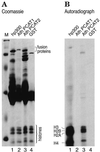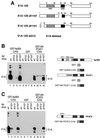Plant orthologs of p300/CBP: conservation of a core domain in metazoan p300/CBP acetyltransferase-related proteins
- PMID: 11160878
- PMCID: PMC30400
- DOI: 10.1093/nar/29.3.589
Plant orthologs of p300/CBP: conservation of a core domain in metazoan p300/CBP acetyltransferase-related proteins
Abstract
p300 and CBP participate as transcriptional coregulators in the execution of a wide spectrum of cellular gene expression programs controlling cell differentiation, growth and homeostasis. Both proteins act together with sequence-specific transcription factors to modify chromatin structure of target genes via their intrinsic acetyltransferase activity directed towards core histones and some transcription factors. So far, p300-related proteins have been described in animals ranging from Drosophila and Caenorhabditis elegans to humans. In this report, we describe p300/CBP-like polypeptides in the plant Arabidopsis thaliana. Interestingly, homology between animal and plant p300/CBP is largely restricted to a C-terminal segment, about 600 amino acids in length, which encompasses acetyltransferase and E1A-binding domains. We have examined whether this conservation in sequence is paralleled by a conservation in function. The same amino acid residues critical for acetyltransferase activity in human p300 are also critical for the function of one of the plant orthologs. Remarkably, plant proteins bind to the adenovirus E1A protein in a manner recapitulating the binding specificity of mammalian p300/CBP. The striking conservation of an extended segment of p300/CBP suggests that it may constitute a functional entity fulfilling functions that may be essential for all metazoan organisms.
Figures





References
-
- Eckner R., Ewen,M.E., Newsome,D., Gerdes,M., DeCaprio,J.A., Lawrence,J.B. and Livingston,D.M. (1994) Molecular cloning and functional analysis of the adenovirus E1A-associated 300-kD protein (p300) reveals a protein with properties of a transcriptional adaptor. Genes Dev., 8, 869–884. - PubMed
-
- Bayley S.T. and Mymryk,J.S. (1994) Adenovirus E1A proteins and transformation. Int. J. Oncol., 5, 425–444. - PubMed
-
- Chrivia J.C., Kwok,R.P.S., Lamb,N., Hagiwara,M., Montminy,M.R. and Goodman,R.H. (1993) Phosphorylated CREB binds specifically to the nuclear protein CBP. Nature, 365, 855–859. - PubMed
-
- Bannister A.J. and Kouzarides,T. (1996) The CBP co-activator is a histone acetyltransferase. Nature, 384, 641–643. - PubMed
Publication types
MeSH terms
Substances
Associated data
- Actions
LinkOut - more resources
Full Text Sources
Other Literature Sources
Molecular Biology Databases
Miscellaneous

